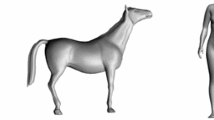Abstract
We have developed a CG technique that creates real-time animations of spark discharges. The technique proposed in this paper has factors related to the generation of a discharge, such as electric charge distribution and boundary conditions in a virtual space as the input, and generates spark discharge shape patterns based on the electric field defined by the input information. An electric field is expressed by the Laplace equation. Our method efficiently obtains the numerical solution of the equation using the calculation technique of the conjugate gradient method implemented on GPU, and can cope with dynamic changes in input. It also produces discharge patterns in both two and three dimensions. In addition, an efficient pseudo-dimensional expansion technique is proposed in this paper, which uses multiple two-dimensional electric fields to generate three-dimensional discharge patterns.
Similar content being viewed by others
References
Dobashi, Y., Yamamoto, T., Nishita, T.: Efficient rendering of lightning taking into account scattering effects due to clouds and atmospheric particles. In: Proc. Pacific Graphics 2001, pp. 390–399 (2001)
Glassner, A.: The digital ceraunoscope: Synthetic thunder and lightning, part 1. IEEE Comput. Graph. Appl. 20(2), 89–93 (2000)
Glassner, A.: The digital ceraunoscope: Synthetic thunder and lightning, part 2. IEEE Comput. Graph. Appl. 20(3), 92–96 (2000)
Hayami, T.: Full of Mysteries – The Science of Lightning (in Japanese). Kodansha (1996)
James, G.: Real-time glow. In: R. Fernando (ed.) GPU Gems, pp. 343–362. Addison-Wesley (2004)
Kim, T., Lin, M.: Physically based animation and rendering of lightning. In: Proc. Pacific Graphics 2004, pp. 267–275 (2004)
Kitagawa, S.: Science of lightning and thundercloud – How to protect yourself from lightning (in Japanese). Morikita Shuppan (2001)
Krüger, J., Westermann, R.: A GPU framework for solving systems of linear equations. In: M. Pharr (ed.) GPU Gems 2, pp. 703–718. Addison-Wesley (2005)
Kruszewski, P.: A probabilistic technique for the synthetic imagery of lightning. Comput. Graph. 23(2), 287–293 (1999)
Narasimhan, S., Nayar, S.: Shedding light on the weather. In: Proceedings of IEEE CVPR, vol. 1, pp. 665–672 (2003)
Niemeyer, L., Pietronero, L., Wiesmann, H.J.: Fractal dimension of dielectric breakdown. Phys. Rev. Lett. 52(12), 1033–1036 (1984)
OpenGL.org Web site, advanced graphics programming techniques using OpenGL, Course notes, SIGGRAPH99, Mathematics of separable convolution, http://www.opengl.org/resources/tutorials/sig99/advanced99/notes/node235.html
Reed, T., Wyvill, B.: Visual simulation of lightning. In: Proceedings of SIGGRAPH 1994, pp. 359–364 (1994)
Sosorbaram, B., Fujimoto, T., Muraoka, K., Chiba, N.: Visual simulation of lightning taking into account cloud growth. In: Proceedings of CGI 2001, pp. 89–95 (2001)
Takayasu, H.: Simulation of electric breakdown and resulting variant of percolation fractals. Phys. Rev. Lett. 54(11), 1099–1101 (1985)
Author information
Authors and Affiliations
Corresponding author
Rights and permissions
About this article
Cite this article
Matsuyama, K., Fujimoto, T. & Chiba, N. Real-time animation of spark discharge. Visual Comput 22, 761–771 (2006). https://doi.org/10.1007/s00371-006-0061-z
Published:
Issue Date:
DOI: https://doi.org/10.1007/s00371-006-0061-z




